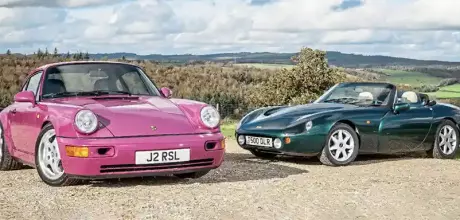Porsche 911 Carrera RS 964 vs. TVR Griffith 500
Can the Porsche 911 Carrera RS 964 and TVR Griffith 500 truly be compared? They may seem poles apart, but this pair has more in common than you might think. Can the underdog from Blackpool hold the Stuttgart icon to account?
Words SAM DAWSON
Photography LAURENS PARSONS
Icon vs the Underdog
They’re both early-Nineties supercar-slayers, but can TVR’s
Griffith 500 take on the Porsche 964 Carrera RS, despite today’s tenfold price difference?
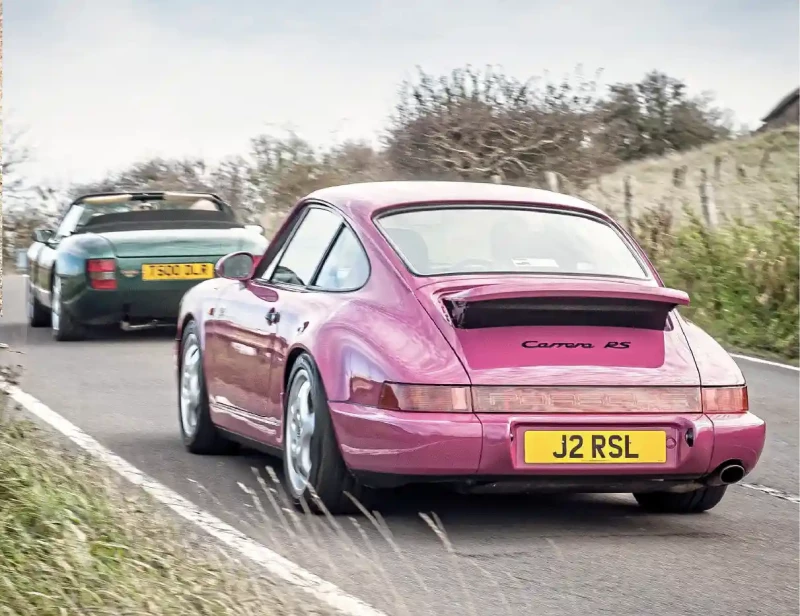
On paper, the TVR Griffith 500 and Porsche 964 Carrera RS are surely incomparable. As a classic the Carrera RS is following in its hallowed Seventies predecessor’s tyretracks, commanding the best part of £240,000, more for low mileage or rare spec; the best Griffith won’t set you back a tenth of that. Porsche is a thriving multinational engineering giant, while TVR exists in name only nowadays, clinging on to the domestic affection for a firm that hand-built plastic-bodied sports cars in small numbers in its Blackpool factory.
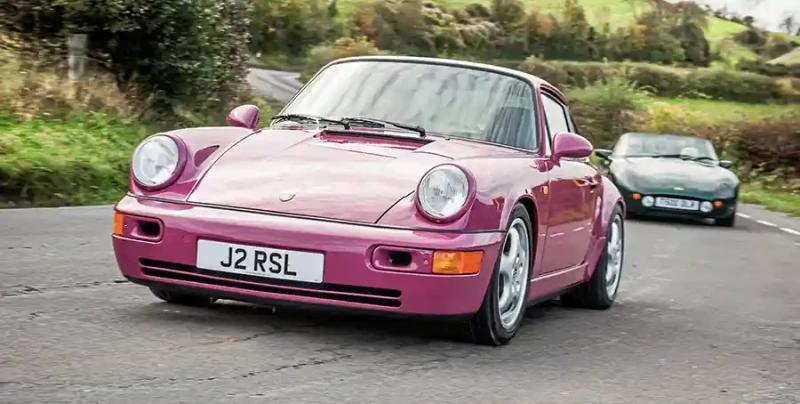
Ardent Porschephiles have probably lost count of the number of times it has won the Le Mans 24 Hours outright, even before the rest of the world’s classic sportscar races are taken into account. TVR, plucky contender though it was, remains a clubman’s favourite but a mere minnow even compared to compatriots like Lotus. There has never been a TVR equivalent of Porsche’s mighty 917 or 962 sports-prototypes, TVR hasn’t built a victorious Formula One engine, nor did firms ever approach TVR to design, say, skiing helmets or sunglasses. And yet, this pair is comparable. Both represent the ultimate evolution of brand-defining engineering concepts laid down in the Forties, yet which wouldn’t outlast the Nineties. Both were born out of one-make race series which themselves resulted from the turmoil of the Eighties GT-racing landscape. Both have reputations for being fearsome to handle on the limit, the preserve of expert drivers only. And perhaps most pertinently, their performance figures are all-but identical, each offering 60mph in just under five seconds and a top speed of, as near as makes no difference, 160mph.
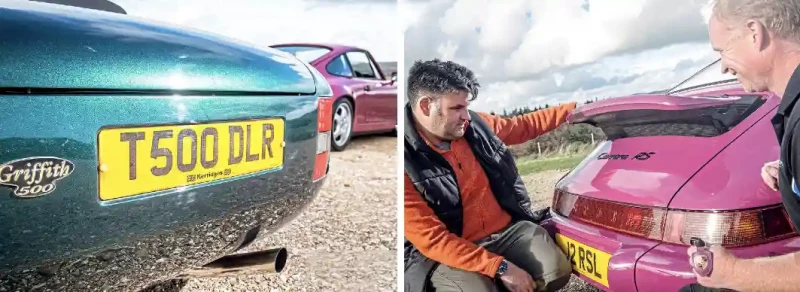
So with this in mind, is the Porsche 964 Carrera RS really worth every penny of £240,000? Or to put it another way, is the £20k TVR Griffith 500 one of the biggest classic performance bargains ever seen? Let’s find out…
Design and Engineering
On the surface of it, the Porsche 964 Carrera RS looks like a detail evolution of the original 1964 911. In fact, this Rubystone Red example – a colour unique to the RS but highly reminiscent of the lurid colour-coding so beloved by German aftermarket Porsche tuners in the Eighties – could almost pass for some creation of Ruf or Gemballa, with an adulterated 911 to be found somewhere beneath its hiking-boot-sole bumpers.
However, it’s actually the work of Ben Dimson, the stylist behind Porsche’s 959. While the twin-turbocharged four-wheel-drive Group B supercar retained some 911 principles – the rear-mounted flat-six engine and unmistakable roofline silhouette – it also represented the first coherent attempt to evolve the stylistic concept beyond the awkward aerodynamic add-ons that had sullied Ferry Porsche’s original shape since the Seventies. There’s a beautiful sense of flow to the 959’s lines.
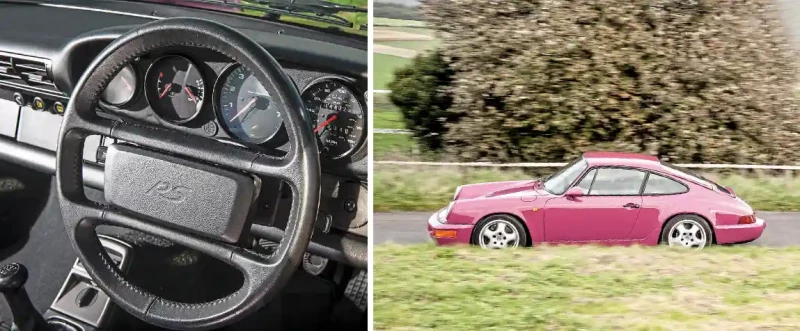
Unfortunately, working with unyielding underlying source material still rooted in the Sixties, Dimson’s attempt to modernise the 911 shape with 959-style cues isn’t entirely visually successful. Those smoothed, slatted bumpers look too big for the car underneath, a problem exacerbated further with the RS. The lower suspension of the sportier model left the fat rear bumper perilously close to the ground, necessitating a slimmer restyle which relocated the numberplate illumination to either side of the recess.
Writing upon the 964’s launch in 1989, Porsche authority Paul Frère only briefly touched on the styling, regarding it as a scientific upgrade rather than something overtly aesthetic. ‘The new 911 has been aerodynamically optimised without any notable alteration of its basic shape,’ he noted in Porsche 911 Story. Officially, Porsche claimed a drag reduction from 0.39 to 0.32Cd although Frère noted that some aerodynamic trim on the previous generation of 911s had taken this as high as 0.41.
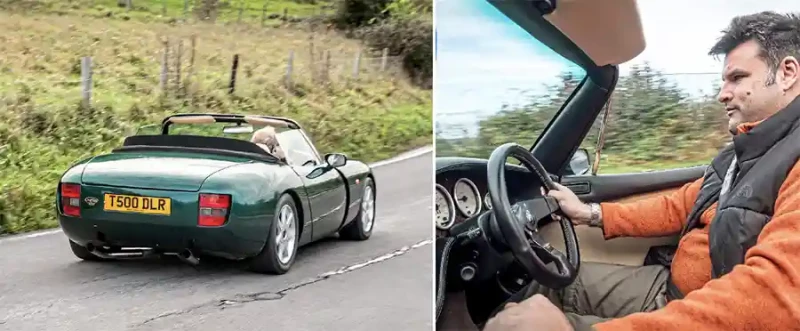
Addressing criticism that the 964 hadn’t visually evolved much compared to its predecessor 911s, CAR’s Georg Kacher asked Ferry Porsche whether any original Sixties parts could be carried over to the current model. ‘I doubt it,’ Ferry said. ‘Over the years the power output has gone up to more than 300bhp. Since the car had to be modified accordingly, there are virtually no carry-over items.’
Because while the 964 may have looked like business as usual – including an interior virtually unchanged since the Sixties – huge strides had been taken under its familiar skin. The 964’s suspension was completely redesigned. Out went antiquated torsion bars in favour of coil springs and telescopic dampers; in came power steering and antilock brakes. The result was a more tightly controlled set of rear semi-trailing arms, which when coupled to wider, grippier tyres and optional four-wheel drive, made the 911 a lot less tail-happy.
In this Carrera RS, as well as stiffer suspension, weight saving was taken to extremes. Windows are manually wound, doors open via pull-straps, and there are no rear seats. Bonnet and doors are lightweight aluminium, seats are one-piece buckets. Perhaps most bizarrely, Porsche compromised its once-market- leading 10-year anti-perforation warranty, dropping it to three years to reflect the use of fewer rust preventatives. The result was a car that weighed 1217kg – with 256bhp in the tail.
Although it looks like a spoiler, and a nod to the 1973 RS’s famous ‘ducktail’, the panel that raises at speed on the Porsche’s rump creates a ram-air scoop to cool the engine while contributing to the near-zero rear lift design of the 964 body. By contrast, there’s a timeless quality to the TVR. Although its head- and taillight treatments are resolutely Nineties, the taut organic shape with its ovoid themes recalls the likes of the Jaguar E-type, Lotus Elite Type 14, and TVR’s Sixties Grantura.
Oddly enough for such a coherent shape, its design process was rather ad-hoc, as stylist John Ravenscroft recalled to Classic Cars in 2017. ‘It was styled in foam rather than clay,’ he said. ‘We used a surfboard-type material to sculpt the Tuscan Challenge racer, and [TVR boss] Peter Wheeler suggested it could be done even quicker if we used spray foam, so we bought a roof-insulator machine and sprayed into box-shaped formers.’ The pair then carved shapes into the foam with craft knives. ‘Peter wanted to replace the S with a car inspired by the MGB and Triumph TR4; I felt it was too old-fashioned. We took a side of a model each, one for my idea, the other for his. Mine became the Griffith, his the Chimaera. Peter was insistent that it should have upright headlights. I got sick of this, took a wood saw to my side and created a sloping oval aperture. It was then that the S replacement became two cars – the Griffith was the more radical-looking car, so we knew we could charge more for it, while the Chimaera was more conservative and would sell in larger numbers at a lower price.’
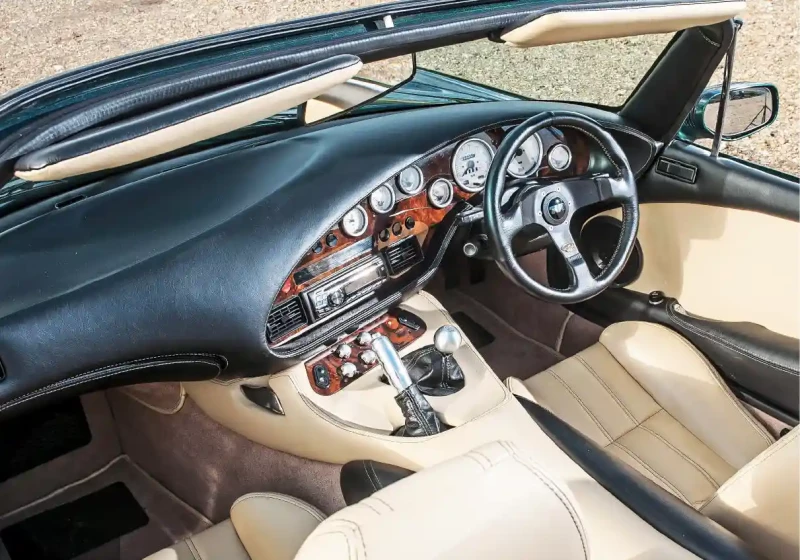
With the decision to make the Griffith a more exclusive creation than the old S, Wheeler and Ravenscroft turned to the TVR ‘White Elephant’ prototype and the one-make Tuscan Challenge racing car for engineering inspiration. Wheeler’s ‘Elephant’ used the racer’s chassis, which included a near-horizontal radiator allowing for a very low nose, and Ravenscroft’s bumperless body design featured flush-glazed light units and a backlit rear numberplate for smoothness. The physical construction of the Griffith – a glassfibre body on a tubular backbone chassis with a bought-in front-mounted power unit – was as intrinsic to the essence of TVR as rear-mounted aircooled horizontally-opposed-engine coupés was to Porsche. However, the Griffith’s chassis is essentially that of a Tuscan Challenge racer, minus the rose-joints in the suspension for the sake of ease of ownership and reduced noise, vibration and harshness. In 2002 chassis engineer Neill Anderson confirmed that the original intention had been to create a roadgoing version of the Tuscan Challenge car in 1989, and a prototype was shown, but racing elements such as the simple roof and flip-front bonnet resulted in something too crude to be marketed as a road car. But the idea remained, and resurfaced the moment Ravenscroft’s styling proposal took a more dramatic turn than Wheeler’s.
Under the bonnet, the tuning state of the Rover V8 reflected developments on the track too. Having taken control of North Coventry Kawasaki, rebranding it TVR Power, TVR had developed a 4.5-litre version of the Rover V8 for use in the Tuscan Challenge racer, generating 360bhp and 350lb ft of torque. TVR Power’s 5.0-litre roadgoing evolution of the engine was less peaky but nearly as powerful as the racer – 325bhp and 360lb ft, delivered at 5600 and 3750rpm respectively, rather than the racer’s 7000 and 6000. Either way, the car built on the racer’s chassis, with sleeker styling, now had racing levels of power. In terms of performance, it achieved with V8 grunt what the 964’s engineers managed with weight-saving purity.
Cultural influence
Despite its reputation as the pinnacle of Porsche 911 evolution, the 964 Carrera RS arrived at the wrong time to make much immediate impact. It was too extreme for many to consider as a road car and the early Nineties marked the point where Eightiessurfing Porsche very nearly hit the buffers, its cars tarnished by association with a get-rich-quick mentality that soon looked vulgar and many held responsible for crashing economies. However, Porsche’s commitment to motor sport, and raceready models like the Carrera RS and its entry-level sibling 968 Club Sport, meant it was ideally placed to cash in on the return of GT racing from 1993. The 964 also attained Hollywood action-hero status with Will Smith in 1994’s Bad Boys, then more recently with Charlize Theron in Atomic Blonde, and as Mirage, a ‘robot in disguise’ in Transformers: Rise Of The Beasts. On the surface of it, the TVR Griffith 500’s cultural impact was negligible. Its sole starring role was in a TV movie, Jilly Cooper novel adaptation The Man Who Made Husbands Jealous, after Rik Mayall had driven a more basic 4.0-litre car on the small screen in Dancing Queen. However, these somewhat sells the Griffith’s cultural impact short.
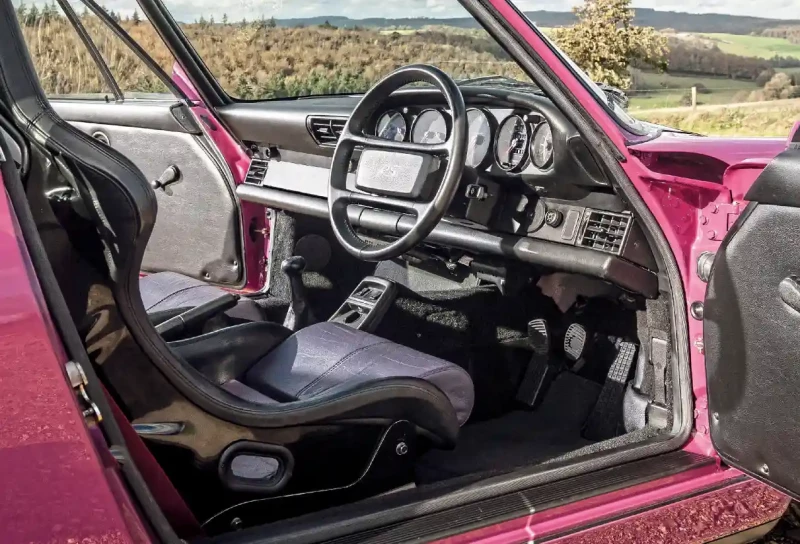
The sheer pull of its styling and performance made an immediate impact in car magazines and on TV motoring shows. Combined with reasonable running costs brought about by liberal use of the Rover parts bin, before long TVR became a Nineties celebrity go-to, something unthinkable in any of its preceding four decades. They didn’t all drive Griffiths, but in the Nineties footballers David Beckham (who was a serial customer) and Rio Ferdinand among several other Premiership rivals, rock stars Gary Numan and Keith Flint, comic actors Vic Reeves, Dawn French, Rowan Atkinson and Tony Robinson (so, both Blackadder and Baldrick), and opera singers Russell Watson and Alfie Boe (who used to work at the TVR factory himself ), all beat a path to Blackpool. As a result, it wasn’t long before TVRs became a common sight in the background of photos run in glossy celebrity magazines. Not as effective as a Hollywood blockbuster, but arguably no publicity is bad publicity.
Driving impressions
These cars give off remarkably similar exhaust notes for machines so differently engineered. I’m expecting a muted metallic thrash from the Porsche and a deep bassy rumble from the TVR, but thanks to the RS’s lack of sound-deadening and the 5.0-litre TVR’s higher-revving race-bred development, they both meet with a mid-octave warble emerging from their tailpipes. The TVR has a beautiful purity to almost every aspect of it, the Griffith hailing from just before Blackpool started doing daft things with doorhandle placements or festooning the innards with beautifully turned but unmarked switches and illegible dials. The overall impression, even before you turn the ignition key, is one of driver-friendly compliance, far from the musclecar monster the Griffith 500 is often made out to be.
The V8 is fiery and free-spinning too, feeling more like a Maserati’s thoroughbred powerplant than something mass-market. In a way it is – although technically Rover engines, these big-bore units were the creations of TVR Power, their displacements and components not matching anything used under the bonnet of an SD1, Morgan Plus Eight or Range Rover. You can get the most out of it too. The gearbox is beautifully slick, the pedals are neatly spaced and weighted, and despite being a roadster there’s a lack of scuttle-shake even with the hardtop stashed in the boot; testament to being designed as a convertible around a separate backbone chassis, rather than a structurally compromised monocoque.
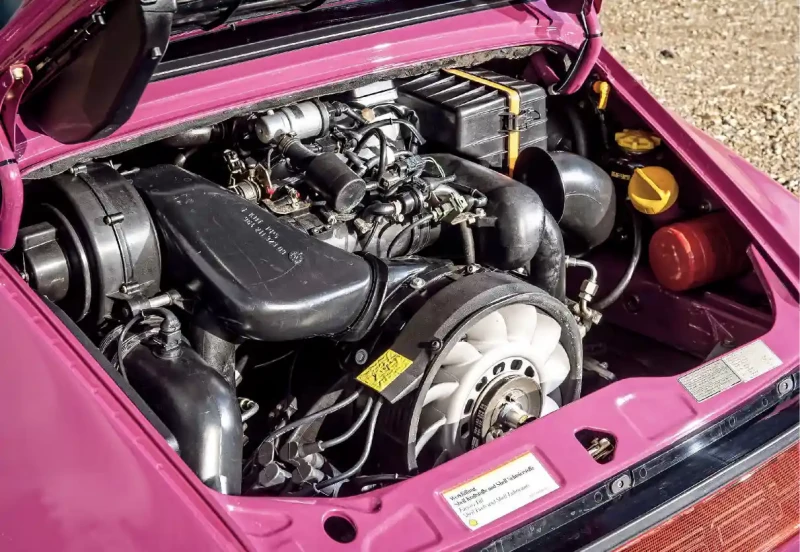
The steering is heavy at parking speeds, but that’s the only point at which it lives up to the car’s brutish reputation. I’m reminded of the ‘big’ Austin-Healey actually, a breed with an image of being oversized, burly and hard to handle, but which in reality was merely being compared to daintier sports cars from the class below. Like the Austin-Healey 3000, the Griffith tackles corners with delicacy and poise. The weight of the engine in the nose doesn’t threaten to overwhelm the chassis because it’s set behind the front axle line, in fact the sense of neutrality and balance is genuinely reminiscent of an original Lotus Elan. Ride quality is excellent.
Performance is in another league though. There’s a linear quality to its power delivery. Point it at the horizon, squeeze the throttle, and it reels in the scenery with the kind of violence a previous generation of Italian thoroughbreds exclusively made their own. Thanks to that sense of balance, plus the tyres’ grip, it’s easy to keep the Griffith in check through corners too. The brakes lack ABS, but Wheeler always claimed this was in the name of improving feel. He was right.
However, I can’t help but wonder what happens when you reach its limits. There are no spoilers sullying the soapbar shape in an attempt to keep it tuck to the road. I’m driving on a dry sunny day today, but a wet slippery road could see those brakes locking at high speed. Would the car telegraph danger progressively or let go without warning? Perhaps it’s this sense of the unknown, combined with the 500’s vast performance figures, which generates the ‘Nineties Cobra’ reputation? Plenty of unskilled drivers have learnt the error of unleashing too much of that meaty torque mid corner.
It’s impossible to ignore the Porsche’s sense of extremism. Thanks to high bucket-seat bolsters and an unyielding steering wheel too big and close to my chest to be comfortable, it’s a tricky car to get into. Then there are the pedals – cramped, offset and oddly hinged, with a clutch action that forces me to twist my left leg to avoid hitting the back of the steering wheel when releasing it. Right from the off, I feel as though I’m in a racing car. Like the TVR, the unassisted steering is heavy at rest, much lighter with speed. However, communication through its rim never relents. It’s easily dragged about by a bumpy road, requiring a firm hand and resulting in an upper-body workout on a twisty lane. The gearshift action is workmanlike, not wristflick slick like the TVR, but thankfully it’s moved on from the baulky clunkiness of older 911s.
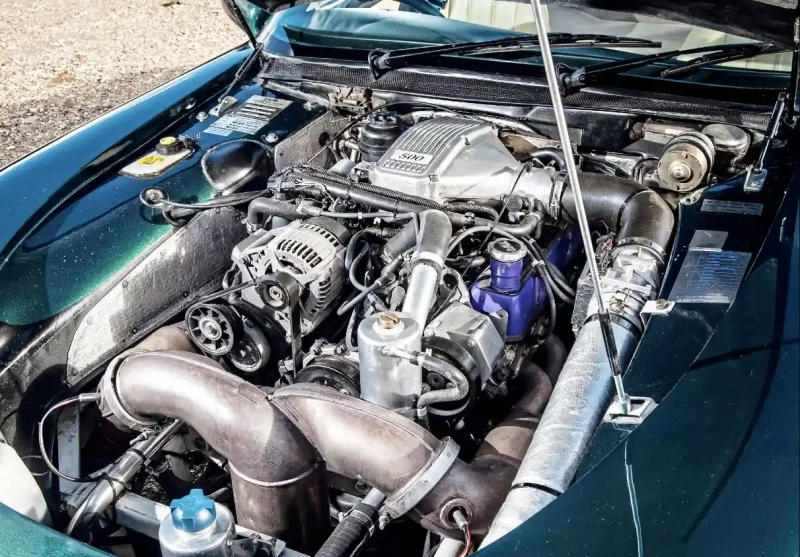
The ride is punishingly stiff though, the turning circle is enormous, and the interior is more sparsely equipped than a prison cell, with not so much as a radio for company. The seats are hard and thinly padded too.
Acceleration, however, is the RS’s – and every 911’s – partypiece. Using its rear-engined physics to its advantage, keeping the right foot down, the weight back and the rear tyres glued to the road is essential to making progress here. After a while, you learn to – as with the TVR – put faith in the tyres’ grip and corner ever-faster. However, all it takes is a sudden need to brake hard and the RS squirrels and squirms, a reminder that the car’s centre of mass is outside of its wheelbase and will spin it round if not treated with respect.
The 911’s racing record speaks for itself. However, a back-to-back drive hasn’t convinced me that the rear-engined layout is inherently superior to the TVR’s more traditional front-mid 50/50 balance. Given that both these cars deliver near-identical performance, the difference between them on tarmac lies in handling. And frankly, the TVR is easier to exploit on the road. But would a racing driver say the same? I’m not so sure.
Sales and statistics
Porsche promised just 2000 964 Carrera RSs would be built, in order to homologate the model for racing, as well as creating a sense of limited-edition desirability. However, like Ferrari with the F40, Porsche caved in to demand for collectors who’d missed out, and eventually built 2276 examples.
It’s worth pointing out that this production figure includes the competition examples used in the various Carrera Cups around the world. But even given that, it seems the majority were bought by would-be racers: 1910 of those built were in the stripped-out, thinly carpeted lightweight specification. The remaining 366 cars were specified in plusher Touring guise, technically rarer but less sought-after today than the extremist machine they were based on.
Uncannily, TVR sold a remarkably similar number of Griffith 500s – 2351 – although it took until 2002 to do so. Peak years were 1994-8, before its Tuscan successor was launched. It’s worth pointing out, however, that at its peak TVR sold 2000 cars a year. At the time, Porsche built more than 40,000 annually.
Ownership prospects
‘Everything is available for them from Porsche, even the RS-specific parts,’ says specialist Mark Sumpter of Paragon Porsche. ‘Frankly, running one is just like any other 964, which is to say dependable and reliable. Yes, there was less underseal applied at the factory, so if someone wanted to use one regularly I’d recommend undersealing it and using a more conventional set of wheels rather than the magnesium ones in winter, but I’ve never actually seen a rusty one. They have slightly different brake pads from a standard 964, but those aren’t expensive. I’d go so far as to say they’re cheaper to run than other 964s because they have fewer electrics to go wrong.
‘However, some were used heavily on track days and in club racing when they weren’t worth quite so much, and you do get accident damage, so make sure it’s been properly repaired. It’s not worth trying to repair mangled thin-gauge aluminium panels; just as well as Porsche sells replacements.
‘The other thing to bear in mind is provenance, because people have built replicas. This especially applies to right-hand-drive examples – just 110 of those were built.’
It’s a not dissimilar situation to running a Griffith 500. Parts are cheaper, but more maintenance is involved, as Jason Clegg of specialist Str8six explains. ‘All parts are available, including TVR-specific bits, because TVR Power still exists; it’s called Powers Performance nowadays. There are a lot of specialists around the country, mainly ex-TVR people including myself, and labour rates are average, rather than supercar-league.
‘The worst years for chassis corrosion were 1998-1999. We were building so many cars that the chassis weren’t sufficiently shotblasted before powdercoating. New outriggers will cost £3.5k all-in, preferable to a full chassis restoration which can cost up to £15k but this is very rare. Everything is fixable though. ‘Towards the end of its life, the Griffith featured more bespoke switchgear. Replacements aren’t available but it’s all repairable. Running costs depend on the maintenance it’s had. A cheap one will demand expenditure. Buy the best you can afford, never skimp on servicing, and it’ll cost you £500-£1500 a year depending on usage.’
Luxurious TVR got more bespoke in time Porsche’s brutal cabin feels race-ready and harsh.
Left-field thinking gave TVR neat details. 911’s spoiler deploys at 50mph.
‘Their performance figures are all-but identical – 60mph in sub-five and a top speed of 160mph’
Backlit ’plate has ’80s concept car origins. 964 shape was optimised for low drag.
‘While the 964 looked like business as usual — including a interior unchanged since the Sixties — huge strides had been taken beneath the skin’
Slick, stubby gear lever is a TVR hallmark.
Folded hood blocks rear view mirror in TVR Steering is pure and direct, but not nervous 500 cost half RS price when new, a tenth now.
Noisy, hardriding RS can’t cruise like TVR Not even a radio in bare-bones RS interior.
‘The RS was too extreme for many to consider as a road car, and in the early Nineties Porsche nearly hit the buffers’
5.0-litre Rover V8 bore/stroke unique to TVR Mainly standard — weight saving made difference.
‘TVR’s V8 is fiery and free-spinning, more like a Maserati’s than something mass-market’
964 reworked so low RS wouldn’t drag bumper.
‘At its peak TVR sold 2000 cars a year. At the time Porsche built more than 40,000 annually’
Wheel feedback borders on overload. 911 964 evolution didn’t make for the prettiest 911.
911’s spoiler deploys at 50mph Porsche feels fraught on narrow lanes TVR’s odd door handles were anti-theft touch Clever roof gave ragtop hardtop solidity when up.
Left-field thinking gave TVR neat details.
WHAT THE MOTORING PRESS THOUGHT BACK THEN
A rarity in automotive media – a Porsche 911 that falls short The press reaction to the 964 Carrera RS in 1991 was surprisingly negative. Autocar & Motor praised its responsiveness, braking power and improved gearchange action, but found its ride harsh, tyre noise ‘unbearable’, and felt it overpriced at £63,544 — some £15k more than the Carrera 2 on which it was based.
‘It’s the best driving machine that Porsche has made in over a decade – and its most uncomfortable road car,’ wrote Roger Bell in CAR. He too felt the standard 964 Carrera 2 represented far better value for money.
By contrast, testers loved the Griffith 500. ‘TVR is in the business of producing cars that perform like supercars but in other respects don’t fit our preconceptions of that breed,’ wrote CAR’s Mark Gilles. ‘Remember, too, before you dismiss V8 pushrod engines as crude, that GT40s thus powered blew the doors off Ferraris at Le Mans,’ Gilles reminded. ‘And it’s £32,995.’
Journalists found the RS too extreme for the road. £33k TVR was a supercar-slaying revelation though.
SPORTING ACHIEVEMENTS
Sanctions, single-marque series and, finally, GT racing The Eighties saw both TVR and the 911 restricted on track: the failure of the FIA-sanctioned Group B racing series followed by its 1986 ban dropped the German car out of contention, while TVR was banned from British production sports car racing because of homologation irregularities and the racing domination of its 420 SEAC. It wasn’t until 1993 that the FIA inaugurated new rules for GT racing that led to the reinvigoration of the sector.
In the meantime, TVR boss Peter Wheeler launched the onemake Tuscan Challenge in 1989 – the Griffith was derived from the car created for it – while the 964RS was devised for use in Porsche’s Carrera Cup in 1992. Both one-make series supported prestigious race meetings, including the British Touring Car Championship and – when the Carrera Cup concept went global – Formula One. Both paved the way for their marques to enter the new FIA GT Championship. Porsche hit the ground running with the 911, and after flirting with a GT1 sports-prototype, TVR ultimately went to Le Mans with the Tuscan R.
Griffith born from Tuscan Challenge car; 964RS formed the basis of Carrera Cup, which went global and continues today.
Porsche or TVR?
So, more in common than you might think, plus the Porsche suffers for its single-mindedness while the TVR unexpectedly broke its maker intothe mainstream. But which comes out on top?
What did the motoring press think of them?
PORSCHE
‘It’s the best driving machine that Porsche has made in over a decade – and its most uncomfortable road car. If the 911 RS has a party-trick, it is to accelerate full bore through the gears on the turn without demanding any special driver skills.’ Roger Bell, CAR, 1991
TVR
‘TVR produces cars that perform like supercars but in other respects don’t fit our preconceptions of that breed. Remember, too, before you dismiss pushrod V8s as crude, that Ford GT40s thus powered blew the doors off Ferraris at Le Mans.’ Mark Gillies, CAR, 1993
How were their designs received?
PORSCHE
‘Optically, above bumper level, it remains the car Ferdinand Alexander Porsche designed more than 25 years ago. The only striking changes are to the bumpers, integrated front air dam and rear skirt. Together with detail improvements like the closing of the rain gutters running along the windscreen pillars, has reduced the drag coefficient to 0.32.’ – Paul Frère, 1989
TVR
‘The car neither looks dated nor obsolete. The front end is beautifully designed because it manages to integrate in a well-balanced manner, the typical Le Mans racer headlights with the other lights housed in the grille. The plain but soft feel of the body side, the simplicity of it, makes it quite difficult to be improved upon.’ – Matteo Conti, former Alfa Romeo designer, 2004
What wider cultural impact did they have?
PORSCHE
The 911 964 Carrera RS is a specialist collectors’ favourite, but enjoys wider recognition thanks to other high-profile 964s appearing in films like Bad Boys, Atomic Blonde and Transformers, and latterly TV series Californication. The RS stayed on the racetrack though.
TVR
Lesser-known and more short-lived, but for a while in the Nineties TVR was the car for the British celebrity-about-town, be it from the worlds of sport, acting, comedy or music. For a while, you were just as likely to see an A-lister climb out of one as you were a Porsche.
What are they like to drive on the road?
PORSCHE
Few cars have felt quite so authentic as roadgoing racers than the Porsche 964 Carrera RS. However, on the road it doesn’t half make you suffer for it. Rock-hard suspension means anything other than smooth tarmac upsets it, and control feedback is in danger of feeling overwhelming. And yet once you’ve successfully pedalled it hard, you’ll feel like a racing driver.
TVR
Perhaps the most surprising thing about the Griffith 500 is how accomplished it feels for a low-volume car. Chassis balance is deft especially given the size of the V8 within it, controls are well-weighted, the interior luxurious and build quality comparable with a Ferrari of the era. But money was saved avoiding things you might wish were there, like rust prevention, aerodynamics and ABS.
What are they like to live with as classics?
PORSCHE
All 964s are tough, well-developed, resilient cars known for clocking up huge mileages. On one hand, running an RS is made simpler by its basic specification, but on the other it’s more likely to have been driven hard on track days and had its aluminium panels mangled in crashes. Buy with care and beware of replicas.
TVR
Parts prices are at Rover, rather than Porsche level. However, the maintenance-intensive nature of handbuilt British sports cars, coupled with uncaring owners and slapdash years at the factory, mean Griffiths often need you to buy more bits for them. A full service history is essential for an easy classic life.


